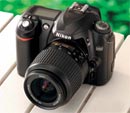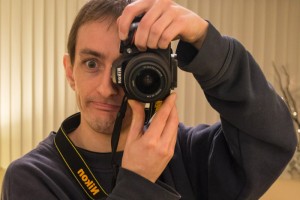I have always had an interest in photography and imaging and I got my first DSLR back in 2005. I started with the Nikon D50 which is the camera used for most of the photography on my website at this time, but I have now upgraded to the Nikon D3200. The image below shows me taking pictures of the sunset near Shaldon, picture taken by my mate Keith who had just bought my D50; that was his first proper photo, not bad!

I still have a lot to learn about photography and I’m gaining experience all the time, I put the best of my attempts into these sectioned galleries here along with some information about the subject and what settings and equipment I used etc.
Nikon D3200 Digital SLR
My second DSLR and a very nice piece of kit. I’m trying to get very professional results and I’m often finding myself competing against pro’s with a lot of very expensive gear, so it was time to upgrade. The quality of your images is not all about the camera body at all, the lenses you use are just as important, however there are a lot of improvements on newer DSLRs such as higher pixel resolution and lower ISO’s which make a lot of difference.
One of the main selling points of my new camera is the massive 24 megapixel resolution, this means the pictures come out at 6016px by 4000px – that’s 4 times larger than 1080p HD video! The advantages of this are in reduction; firstly when you reduce the resolution you get sharper than you would have shooting the same size with less data, but also this extra resolution gives you huge flexibility in cropping; particularly if you only need web resolution at the end – you can make a portrait image from a landscape; or visa-versa; without worrying about losing resolution!
Nikon

Nikon D50
My first SLR and a great camera, many of the older images on my website were taken with the D50. Previously I had a cheap point-n-shoot with dodgy battery life and pretty amatuer results, upgrading to a proper SLR helped me take control of the process, as well as providing a far higher quality lens, and thus acquire better images. SLR stands for single lense reflex which basically means you see directly through the lens when looking through the viewfinder, this means you see the zoom level and focus while you are planning your shot. I’ve got an 18-55mm general purpose lens and a 70-300mm zoom for wildlife and far away objects. A tripod is pretty much essential for clear shots at a distance or in lower light, or for long exposures like fireworks you simply have to have a tripod.
The camera gives full manual control of all the usual features such as shutter speed, aperture (F-numbers) and ISO sensitivity. A top speed of 4000th of a second for capturing crystal clear action and up to 30 sec’s long exposure or using bulb mode the shutter can be held for 30 minutes. I have a remote control for triggering the shutter open and close when using bulb mode for star trails and similar projects.
I’ve also got a 2x right angle finder that extends the viewfinder to a larger size for much more accurate focusing. This is absolutely essential when using lenses that go passed infinity as both of mine do; the reason is that the temperature of the lens can effect where the best focus is and potentially stop you getting to infinity or perfect focus. The main reason I bought this was for focusing on stars when doing astrophotography but I’m now using it a lot in general photography too just to get that perfect focus which is so important. I opted for the far cheaper Seagull model (found on eBay) rather than Nikon’s own, it does the job fine! I’ve just bought a second battery for the D50 too which cost me a fiver rather than the much more expensive Nikon branded battery.


